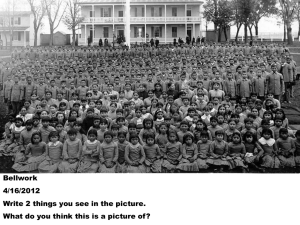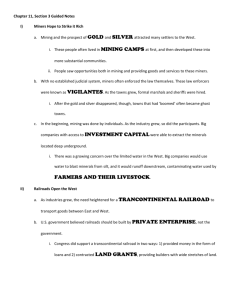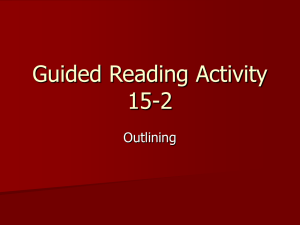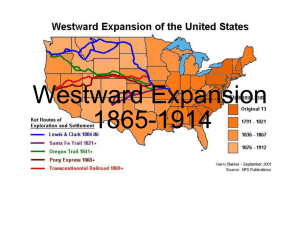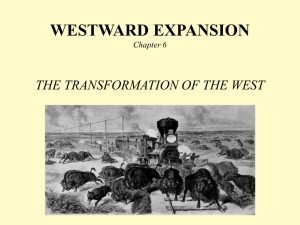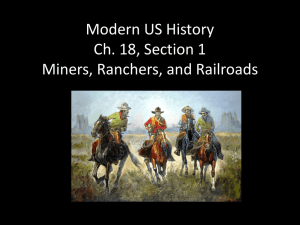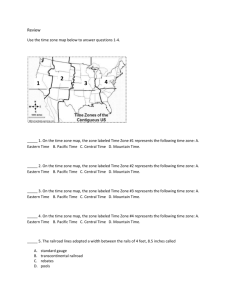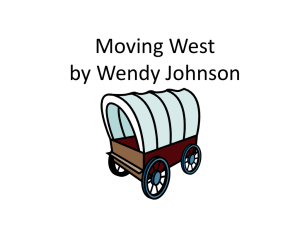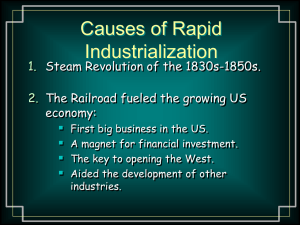1. Speculators - Jenks Public Schools
advertisement
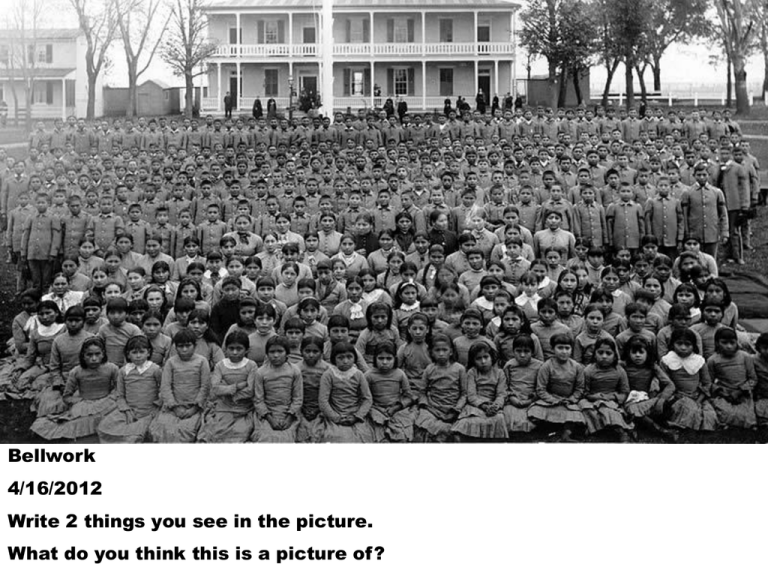
Bellwork 4/16/2012 Write 2 things you see in the picture. What do you think this is a picture of? Pupils at Carlisle Indian school, Pennsylvania. Established in 1879 by Richard Pratt, the school attempted to assimilate Indian children into the "white man's world" through education and financial support. Among its students were four of Comanche chief Quanah Parker's children and those of others involved in the Red River Wars Rath & Wright's buffalo hide yard, showing 40,000 buffalo hides baled for shipment. Dodge City, Kansas, 1878. Land Runs of oklahoma WHY MOVE WESTWARD? Country—growth and pride Land—fresh, cheap; a refuge Wealth—mining and agriculture Adventure—new challenges; leave the past behind Religious freedom B. The Government Passes Legislation to grant land 1. Pacific Railway Acts of 1862 & 1864 gave railroad companies 10 square miles of land on each side of the track for every mile of track laid >> they resold the land to settlers 2. Morrill Land Grant Act (1862) distributed millions of acres of land to state governments>> they could sell the land to found “land-grant” colleges 3. Homestead Act (1862) offered 160 acres of land to settlers who www.nps.gov/home/images/wagon.gif http://www.archives.gov/education/lessons/homestead-act/images/homesteading-family.gif memory.loc.gov/ammem/today/images/0520sodd.gif b. were citizens or citizenship c. paid a $10 registration immigrants who had applied for fee d. built a house within six months e. farmed the land for 5 ownership years before claiming 4. Oklahoma Act of 1889 opened the last of the frontier to new settlers; the “Sooners” sneaked into the territory before the official start and claimed the best land The starting line for the first Oklahoma Land Rush, April 22, 1889. Base camp before the 1889 land run. Boomers at Arkansas City, Kansas, 1889. Photographer: William S. Prettyman. http://www.nationalcowboymuseum.org/research/images/r_a_cunn_imag_lr89_1913_lg.jpg Boomers on Kansas state line, April 19th, 1889. Photographer: William S. Prettyman. Waiting for land run at Purcell, Oklahoma Territory, 1889. Photographer: William S. Prettyman. http://members.virtualtourist.com/m/4e7ae/cf968/ Oklahoma City - April 29, 1889 Seven Days After the Land Run of 1889 ©2002 Oklahoma State Senate Historical Preservation Fund, Inc. and Wayne Cooper C. People Who Moved West 1. Speculators: people who bought large areas of land in hopes of reselling it for a profit 2. Homesteaders: people who offers of free land rushed to accept 3. Exodusters: AfricanAmerican settlers who moved west; took their name from the biblical account of the Jews escaping slavery in Egypt 4. Solid Folk: people who settled down if they liked it or returned east if they didn’t This poster urges Exodusters to move from Kentucky to Kansas. Kansas State Historical Society http://www.cjonline.com/stories/030203/our_ot.hist6.shtml Exodusters waiting for a steamboat to carry them westward in the late 1870's. 5. Boomers: people who kept relocating from town to town looking for a quick fortune, but seldom staying long enough to make a living D. Problems Facing Settlers 1. The extremely poor couldn’t afford the “free” land 2. Land companies claimed individuals most of the land, not 3. Resettlement of the Native Americans 4. The “Anglos” (white easterners) overwhelmed the Mexicanos (Spanish-speaking westerners) who lived in the area 5. Scarce resources (water, trees, etc.) 6. Harsh climate (blizzards in prairie fires, insects) winter, heat in summer, 7. Squatters moved onto land that did not belong to them FARMING THE WEST A. Overcoming Problems 1. Irrigation systems used water flow dams, canals and sloping fields to control 2. Windmills drew water from below ground 3. Settlers burned dried buffalo sod manure and built houses of 4. The government created the to help the farmer Department of Agriculture B. New Farming Techniques 1. New equipment: “self-binding” chilled- iron plow (James Oliver), 2. Barbed wire harvester, combine, seed-drill 3. Bonanza farms: farms owned operated like factories with managers and specialized by large companies and machinery, professional laborers 4. Dry farming: planting crops that require less water and keeping fields free of weeds Aerial view of bonanza farm in the late 1800’s to early 1900s. C. Complaints of the Farmers 1. Low agricultural prices – increased output, competition 2. Insufficient and expensive credit – high interest rates, defaults on loans 3. High rates charged by middlemen 4. High industrial prices – machinery, etc. 5. Tariffs favored industry and hurt agriculture 6. Demonetizing of silver (no more minted coins made from silver) 2. Farmers’ Alliance: organized to unify concerns of farmers with miners and factory workers 3. The Populist Party a. farmers and labor political party unions formed a new 1) free and unlimited coinage of silver RAILROADS & MINING A. A Rush for Gold. 1. People had been looking for in California gold since the ’49 rush 2. Discovery of silver in Nevada led to more strikes (the Comstock Lode) 3. By the late 1800s people flocked to the West, Canada, and Alaska http://i66.photobucket.com/albums/h270/kule1/479px-California_Gold_Rush_handbill.jpg C. “Boom to Bust” GOLD OR SILVER STRIKE Miners arrive to build a tent city Merchants arrive to supply miners Wood-frame structures replace tents BOOM TOWN Mining production falls Miners move on Stores close and merchants leave Town is abandoned GHOST TOWN E. Railroaders 1. The federal government helped the railroad companies because it would benefit the entire nation; a subsidy is financial aid from the government 2. Two railroad companies railroad started a transcontinental Transcontinental Railroad Central Pacific Promontory Point, UT 1869 Union Pacific 3. the completion of the railroad in sparked a spirit of unity the country 4. The railroads allowed for rapid people and supplies transport of 5. New states admitted (NV, CO, WA) ND, MT, F. Problems with the railroad 1. labor was scarce >> dangerous, low pay, hard work 2. high rates because of no competition 3. discrimination regarding rates >> rebates to large shippers, rural service high 4. corruption >> bribery, free passes to government officials RANCHERS & COWHANDS A. Ranching in the West 1. Spaniards raised Texas longhorns in the Southwest 2. Sheepherding also profitable, but conflicted with cattle 3. The government allowed cattle as open range (free grazing ranchers to use public lands land) B. The Cattle Industry 1. Ranchers employed cowhands to tend cattle and drive herds to market 2. A cowboy’s skills and dress Mexican vaqueros came from Spanish and 3. The cattle drives followed specific routes leading to railheads, where the cattle were loaded onto railroad cars 4. The railheads became cow towns -- cities that concentrated on the cattle industry C. End of the Cattle Kingdom 1. Surplus of cattle 2. Fencing limited availability of open land 3. Severe weather INDIANS IN THE WEST A. The Plains Indians 1. A wide variety of tribes inhabited the Great Plains 2. Many tribes followed the land as they moved migration of the buffalo, living 3. Societies were highly to men and women structured with specific jobs off the assigned 4. The US government acquired land from the Indians through numerous treaties—the Indians were to receive money and supplies; the Bureau of Indian Affairs managed Indian issues 5. Treaties were periodically broken, new ones made, and then broken again
